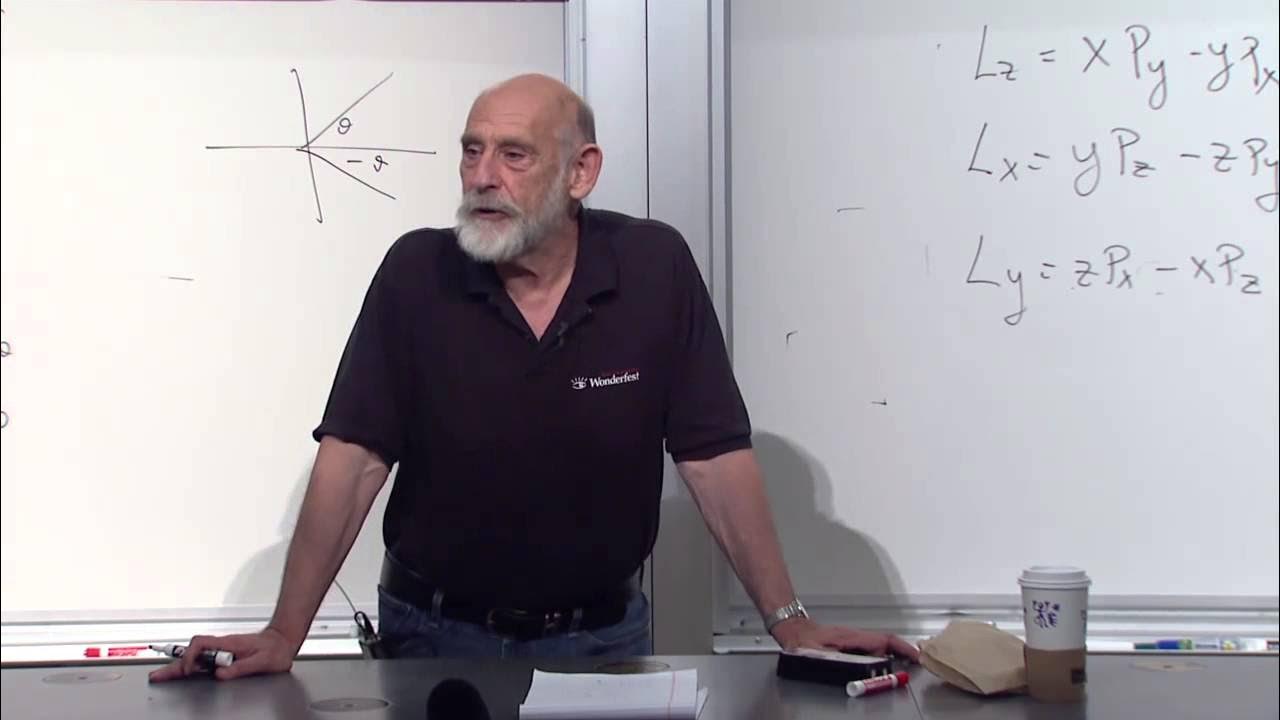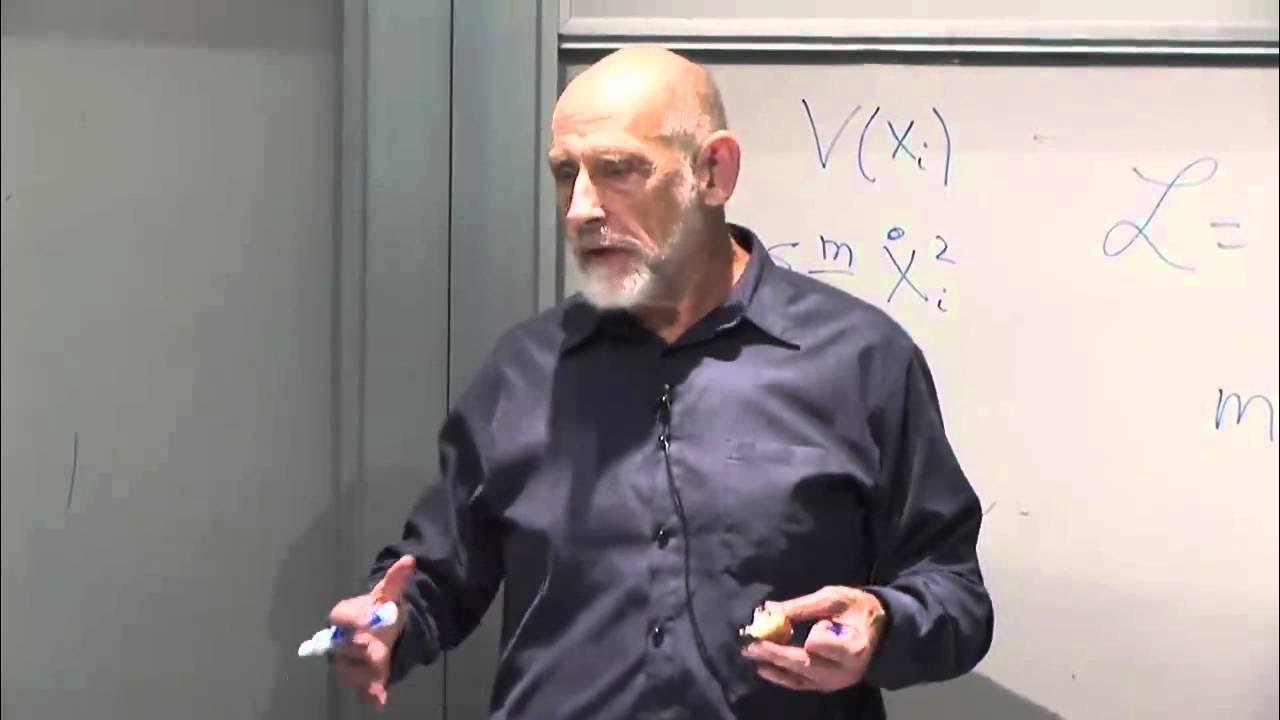Classical Mechanics | Lecture 8
TLDRThe video script is an in-depth lecture on classical mechanics, focusing on the concept of Poisson brackets and angular momentum. The lecturer begins by revisiting Poisson brackets, which are used to define the time derivative of a function along a trajectory in phase space. They explain how these brackets frequently appear in classical mechanics and how they can be generalized for any two functions. The rules of Poisson brackets are discussed, highlighting their anti-symmetric property and their behavior under addition and multiplication. The lecturer then connects Poisson brackets to the conservation of quantities in a system, demonstrating how the brackets can reveal the small changes in a system under certain symmetry operations, such as time translations or rotations. The concept of angular momentum is explored, emphasizing its conservation due to rotational invariance. The lecturer uses Poisson brackets to derive the equations of motion for a harmonic oscillator and to analyze the behavior of a gyroscope, including its precession under the influence of a torque. The script is rich with mathematical expressions and provides a clear understanding of how Poisson brackets can elegantly formulate classical mechanics, particularly in the context of symmetries and conservation laws.
Takeaways
- 📚 The concept of Poisson brackets is introduced as a fundamental tool in classical mechanics, used to formulate mechanics through their use.
- 🚀 Poisson brackets are defined for any two functions in phase space and have properties such as anti-symmetry and linearity, which are crucial for their algebraic manipulation.
- 🔄 Angular momentum is a conserved quantity due to rotational invariance, and its components can be described using Poisson brackets to understand their behavior under rotations.
- 📐 The Hamiltonian, which is a conserved quantity due to time-translation invariance, can be used with Poisson brackets to find the time derivative of any function in phase space.
- 🤔 The time evolution of a system can be understood through the Poisson bracket of a quantity with the Hamiltonian, which gives the rate of change of that quantity.
- 🧮 Poisson brackets can be used to calculate equations of motion, as demonstrated with the example of a harmonic oscillator, without directly invoking Newton's laws.
- 🌀 The components of angular momentum obey specific Poisson bracket relations, which are analogous to the commutation relations in quantum mechanics, and are key to understanding rotational dynamics.
- ⚙️ The behavior of a gyroscope, including its precession, can be analyzed using Poisson brackets, showcasing the power of this mathematical tool in understanding complex motion.
- ⏱️ Time derivatives of dynamical variables are connected to symmetries of the system through Poisson brackets, linking conservation laws with the generators of these symmetries.
- 🔗 The conservation of angular momentum components is maintained if the system is not subjected to an external torque, a principle that can be verified using Poisson brackets.
- 📉 The potential energy of a rotating system in a gravitational field can be expressed in terms of its angular momentum components, which can then be related to the dynamics of the system using Poisson brackets.
Q & A
What is the primary focus of the lecture?
-The lecture primarily focuses on the concept of Poisson brackets in classical mechanics, their relation to symmetries and conservation laws, and their application in studying angular momentum and the motion of a gyroscope.
How are Poisson brackets defined in the context of the lecture?
-Poisson brackets are defined as a mathematical operator that describes the time evolution of a function within a Hamiltonian system. They are used to calculate the time derivative of an arbitrary function along a trajectory in phase space.
What are the basic properties of Poisson brackets mentioned in the lecture?
-The basic properties of Poisson brackets mentioned include antisymmetry (the Poisson bracket of A with B is minus the Poisson bracket of B with A), bilinearity (the bracket of a sum is the sum of the brackets), and the product rule (involving the bracket of a product of functions).
How are Poisson brackets used to derive the equations of motion for a harmonic oscillator?
-Poisson brackets are used to derive the equations of motion for a harmonic oscillator by taking the time derivative of the position and momentum coordinates, which are then shown to be related to the Hamiltonian of the system.
What is the connection between Poisson brackets and symmetries in physics?
-The connection between Poisson brackets and symmetries is that Poisson brackets generate transformations corresponding to the symmetries of the system. If a quantity is conserved due to a symmetry, its Poisson bracket with the Hamiltonian is zero, and vice versa.
How does the lecturer use Poisson brackets to discuss angular momentum?
-The lecturer uses Poisson brackets to show how the components of angular momentum behave under rotations. By calculating the Poisson brackets of the angular momentum components with respect to each other, the lecturer demonstrates the conservation of angular momentum and the resulting motion, such as precession.
What is the significance of the Hamiltonian in the context of Poisson brackets?
-The Hamiltonian is significant because it is used to compute the time evolution of dynamical variables in the system. The time derivative of any variable is given by its Poisson bracket with the Hamiltonian, which is a key aspect of Hamiltonian mechanics.
What is the role of the angular momentum vector in the discussion of a gyroscope?
-The angular momentum vector is crucial in the discussion of a gyroscope because it determines the behavior of the gyroscope when subjected to external forces or torques. The lecturer assumes that the angular momentum is large and aligned with the axle of the gyroscope, which simplifies the analysis of its motion.
How does the lecturer demonstrate the precession of a gyroscope?
-The lecturer demonstrates the precession of a gyroscope by considering the potential energy due to gravity and its relationship with the angular momentum vector. By taking Poisson brackets of the components of angular momentum with the potential energy, the lecturer shows that the vertical component of angular momentum remains constant while the horizontal components evolve, leading to precession.
What is the meaning of the term 'conserved quantity' in the context of the lecture?
-A 'conserved quantity' in the context of the lecture refers to a physical quantity that does not change over time in a system that exhibits a particular symmetry. For example, angular momentum is a conserved quantity due to rotational symmetry, and energy is conserved due to time-translation symmetry.
How does the lecturer relate the conservation of angular momentum to the motion of a rigid body?
-The lecturer relates the conservation of angular momentum to the motion of a rigid body by using Poisson brackets to show that the time derivative of each component of the angular momentum vector is zero when there is no external torque. This leads to the conclusion that the direction of the angular momentum vector remains constant, which is a key aspect of the motion of a rigid body, like a gyroscope, under the influence of gravity.
Outlines
📚 Introduction to Poisson Brackets and Angular Momentum
The first paragraph introduces the concept of Poisson brackets in the context of classical mechanics. It discusses how these brackets are used to formulate mechanics and how they relate to the time derivative of a function along a streamline. The paragraph also touches on Hamilton's equations and how they connect to the Poisson bracket of a function with the Hamiltonian.
🔍 Exploring the Properties and Rules of Poisson Brackets
This section delves deeper into Poisson brackets, explaining their anti-symmetric property, linearity, and the effect of multiplying a function by a constant. It also highlights the importance of these brackets in classical mechanics, showing how they can be used to formulate the equations of motion for a harmonic oscillator.
📐 Special Cases of Poisson Brackets and Angular Momentum
The third paragraph focuses on special cases of Poisson brackets, particularly the brackets of position and momentum functions. It explains that the Poisson bracket of two position functions or two momentum functions is zero, while the bracket of a position function with a corresponding momentum function is nonzero. This leads to the introduction of the angular momentum operator.
🧮 Using Poisson Brackets to Calculate Equations of Motion
Here, the script demonstrates the application of Poisson brackets to derive the equations of motion for a harmonic oscillator. By using the Hamiltonian of the system and applying the Poisson bracket rules, the equations of motion are obtained, showcasing the power of this mathematical tool in classical mechanics.
🌀 Angular Momentum and Rotational Dynamics
The fifth paragraph explores angular momentum in the context of rotational invariance. It explains how the conservation of angular momentum is related to the symmetry of rotation and how Poisson brackets can be used to express this conservation. The connection between the Poisson bracket of angular momentum components and the equations of motion for rotating bodies is also discussed.
🔄 The Poisson Brackets of Angular Momentum Components
This section investigates the Poisson brackets between different components of the angular momentum vector. It shows that taking the Poisson bracket of a component with another can reveal the small changes that occur during rotations, providing insight into the dynamics of rotating systems.
🚀 Application of Poisson Brackets to Symmetry and Conservation Laws
The seventh paragraph establishes a connection between Poisson brackets, symmetry operations, and conservation laws. It demonstrates that for every symmetry in a system, there is a corresponding conservation law, and Poisson brackets can be used to identify the transformation associated with a conserved quantity.
🤔 Reflecting on Poisson Brackets and Their Implications
The final paragraph prompts reflection on the significance of Poisson brackets. It emphasizes that these brackets are not just a mathematical convenience but a powerful tool for understanding the underlying symmetries and conservation laws in physical systems.
Mindmap
Keywords
💡Pome brackets
💡Angular momentum
💡Hamilton's equations
💡Symmetry
💡Conservation laws
💡Harmonic oscillator
💡Gyroscopic motion
💡Precession
💡Moment of inertia
💡Gravitational potential energy
💡Phase space
Highlights
Introduction to Poisson brackets and their significance in classical mechanics.
Explanation of how Poisson brackets relate to the time derivative of a function along a trajectory in phase space.
Derivation and discussion of Hamilton's equations using Poisson brackets.
Generalization of Poisson brackets for any two functions in phase space, not just the Hamiltonian.
Lecture on the algebraic rules associated with Poisson brackets, including anti-symmetry and linearity properties.
Illustration of how Poisson brackets can be used to formulate classical mechanics elegantly.
Calculation of equations of motion for a harmonic oscillator using Poisson brackets.
Connection between Poisson brackets and the conservation of angular momentum due to rotational invariance.
Demonstration of how Poisson brackets can be used to find the small change in a quantity under a symmetry operation.
Analysis of the relationship between symmetries, conservation laws, and Poisson brackets in classical mechanics.
Use of Poisson brackets to compute the change in momentum components under translations.
Derivation of the connection between the Hamiltonian, angular momentum, and the conservation laws through Poisson brackets.
Explanation of how the components of angular momentum can be used to determine the behavior of a gyroscope using Poisson brackets.
Discussion on the precession of angular momentum in a gravitational field, analogous to electron spin precession in a magnetic field.
Calculation of the time derivative of angular momentum components to describe the motion of a gyroscope under the influence of gravity.
Final thoughts on the power and utility of Poisson brackets in deriving equations of motion and understanding symmetries in classical mechanics.
Transcripts
5.0 / 5 (0 votes)
Thanks for rating:





